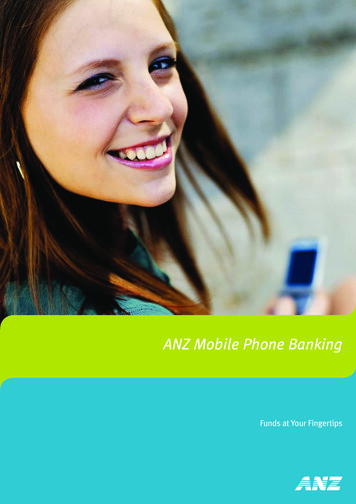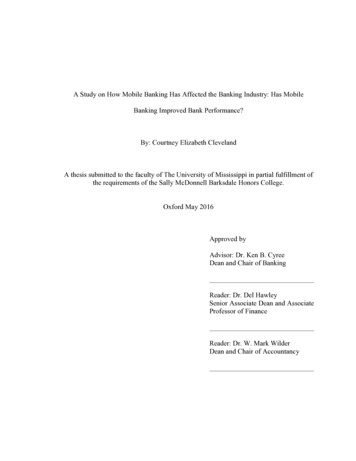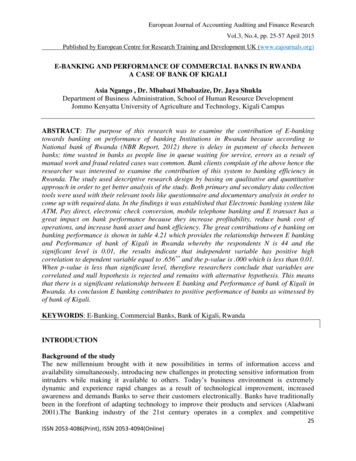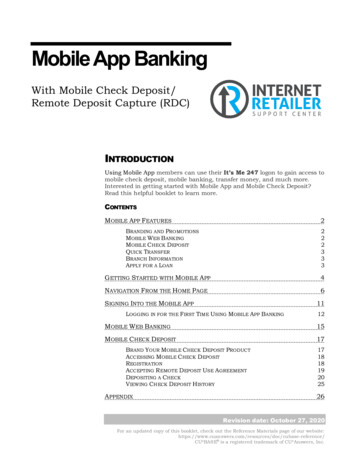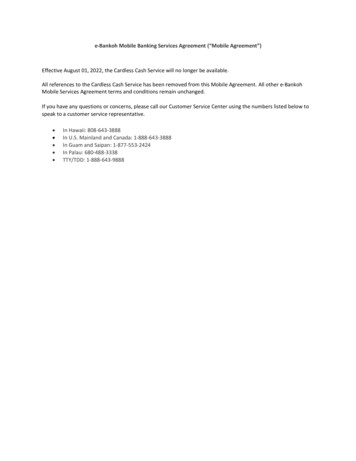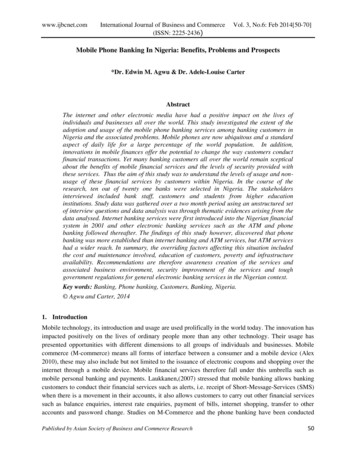
Transcription
ANALYSIS OF MOBILE BANKING FORFINANCIAL INCLUSION IN TANZANIA:CASE OF KIBAHA DISTRICT COUNCILPREPARED BY ANITHA RODGERSISHENGOMA 20111
Table of ContentsABSTRACT . 4CHAPTER ONE . 5INTRODUCTION . 51:0INTRODUCTION . 51:1 BACKGROUND OF THE PROBLEM. 51:2 STATEMENT OF THE PROBLEM . 71:3 RATIONALE OF THE STUDY . 81.4 general Objective of the Study . 91.4.1 SPECIFIC OBJECTIVES . 91:5 RESEARCH QUESTIONS . 91:6 CONCEPTUAL FRAMEWORK . 101.7 The significanCE of the Study . 121.8 LIMITATIONS OF THE STUDY . 13CHAPTER TWO . 14LITERATURE REVIEW . 142:0 INTRODUCTION . 142:1 HISTORY OF M-BANKING . 142:2 SERVICES PROVIDED BY M-BANKING SYSTEMS. 152:3 THE TECHNOLOGY ACCEPTANCE MODEL (TAM) . 162.4 UNDERSTANDING OF DIFFERENT MODELS IN M-BANKING . 182:5 THE BANK-LED MODEL IN M-BANKING FOR A GROWING ECONOMYLIKE TANZANIA . 202.6 M-BANKING IN DEVELOPING COUNTRIES LIKE TANZANIA. 202:7 FINANCIAL SERVICES ACCESSIBILITY IN TANZANIA . 222.8 M-BANKING IN TANZANIA . 232.9 M-BANKING FUTURE IN TANZANIA . 282.10 THE M-BANKING AND FINANCIAL INCLUSION . 312.11 M-BANKING AND THE POOR . 332.12 IMPORTANCE OF M-BANKING IN TANZANIA . 362.13 M-BANKING AND THE CENTRAL BANKS . 382.15 CHALLENGES FOR A MOBILE BANKING SOLUTION . 412.16OTHER APROACHES TO ADDRESS CHALLENGES IN M-BANKING42CHAPTER THREE. 44RESEARCH METHODOLOGY . 443.0 INTRODUCTION . 443.1 RESEARCH TYPE AND APPROACH . 443.1.1 QUANTITATIVE RESEARCH . 453.1.2 QUALITATIVE RESEARCH . 452
3.2 RESEARCH DESIGN . 453.3 YPES AND SOURCES OF DATA REQUIRed . 463.3.1 Primary data collection . 463.3.2 SECONDARY DATA COLLECTION . 473.4 Sampling Design . 483.4.1 POPULATION. 483.4.2 SAMPLING TECHNIQUE . 483.4.3 THE PROBABILITY AND NON-PROBABILITY SAMPLING . 493.4.4 CHARACTERISTIC OF THE SAMPLE . 493.5 DATA ANALYSIS METHOD . 503.6 REALIBILITY AND VALIDITY . 513.7 response rates . 513.8 data measurement . 51CHAPTER FOUR . 52DATA PRESENTATION AND ANALYSIS . 524.0 Introduction . 524:1 THE GENERAL OBJECTIVE . 524.1.1 SPECIFIC OBJECTIVES . 524.2 RESULTS AND DISCUSSION . 534.2.1 To examine the awareness of the operation of mobile banking systems andunderstanding of the technology usage to mobile subscribers. . 54CHAPTER FIVE. 70SUMMARY, CONCLUSSION AND RECCOMENDATION . 705.0INTRODUCTION . 705.1 SUMMARY . 705.2 CONCLUSION . 725.3 RECOMMENDATION . 73REFERENCES. 753
ABSTRACTThe study analyzed the Mobile Banking (M-Banking) system coverage for financialinclusion in Tanzania, the case study of Coast region at Kibaha district council.Objectives of the study were to analyze coverage of M-Banking for financial inclusion,the usage behavior of mobile subscribers to M-Banking services, understand the extentin which mobile banking systems had impeded financial development and theassessment of service effectiveness and service cost charges.The main aim was supported by specific objectives which were determined by using theTechnology Acceptance Model (TAM, 2009). In this model, I could analyze the MBanking system usage behavior of the population understudy.The instruments used were questionnaires and interview which were administered tomobile subscribers and retail agents of the mobile banking systems. The findings werecollected, organized, analyzed and interpreted using SPSS Tables.The outcome indicates that 79% of the population understudies were using the MBanking system technology of which almost 100% has helped in accessing financialservices in an easy way. It further shows that, the illiterate populations are facing thedifficulty in using technology compared to literate one. Also, the service cost charges arestill not clear to the study hence recommending further study into this.However, those who were not registered with any of M-Banking facility they couldshow their interest to use it due to perceived importance of technology in financialaccessibility at an easy of which the same group of those not registered with the facilityshowed their awareness of the service that is believed to be convenient in obtainingservices at an easy way.4
CHAPTER ONEINTRODUCTION1:0INTRODUCTIONFinancial inclusion is the delivery of financial services at affordable costs to sections ofdisadvantaged and low-income segments of society. Mobile Banking refers to activitiesperforming balance checks, account transactions, payments and credit applications via amobile device or Personal Digital Assistant (PDA). Financial inclusion has importantrole in stimulating development by providing banking related financial transactions in aneasy way.1:1 BACKGROUND OF THE PROBLEMThe UNCDF report of January 2009 illustrate that, the financial inclusion has been of animportance in third world countries since the early 2000s after the research findingsabout financial exclusion and its direct correlation to poverty in third world countries. Ithas shown that, the banking services are still inadequate to include people from fullparticipation in accessing financial services such as saving, insurance, payments, shortand long-term credit, pensions or local money transfers.The financial inclusion is now a common objective for many central banks among thedeveloping nations as it addresses the constraints of financial exclusion. Ways ofovercoming financial exclusion have been cited through which the introduction offinancial inclusion facilities to an easy way (Kempson and Dominy, 2003).5
During the second quarter of 2010, Tanzania had a total of 19,592,795 mobilesubscribers. By September 2010 there were about 20,771,487 subscribers who werereceiving services from seven telecommunications companies (Vodacom, Airtel, Tigo,Zantel, TTCL, SaSatel and Benson Informatics (BOL)). Vodacom is the market leaderwith 8,426,097 subscribers followed by Airtel with 5,901,634 subscribers, Tigo with4,575,534 subscribers, Zantel with 1,586,516,Tanzania Telecommunication CompanyLimited with 256,064,Sasatel with 23,071 and BOL with 2571 subscribers (TanzaniaCommunications Regulatory Authority report, 17th January 2011).In Tanzania, the early 2007 Vodacom-Tanzania mobile company introduced a VodafoneM-PESA as a new mobile money transfer service in partnership with Vodafone Group.With M-PESA, Vodacom customers could convert cash into electronic money at anauthorized M-PESA agent. So far the population under which Vodacom-Tanzania hasregistered its subscriber occupies 17.9% of the total population (Vodacom-Tanzaniareport, August 2008).However, the mobile money transfer in Tanzania has been a common objective foralmost all the mobile companies in Tanzania. This could be seen through theintroduction of M-banking system by the four Telecommunications companies namelyM-Pesa, Zap, Tigo Pesa and Z-Pesa.6
1:2 STATEMENT OF THE PROBLEMThe July 2010 estimates of Tanzania total population was estimated to be 41,892,895,thus the population under which Tanzania has registered mobile subscribers occupies49.58% of the total population. The number of mobile subscribers under the aboveTelecommunication company with M-Banking system occupies 48.9% of the totalpopulation i.e 20,489,781 of which 16,391,824.8 i.e. 39% of total population are ruralpeople living under poverty (TCRA, 2011).Taking the consideration of the above figure, the mobile industry in Tanzania by 2010earned the revenue that was doubled amount of what the mining industry got i.e. 2.684billion (TSh3.6trillion) per year, this makes telecommunications be the country’sleading industry (UDSM,2011).According to provisional data as of 30 June 2010, 9.2 million of registered subscribersare for mobile payment services from four mobile operators (Vodacom, Airtel, Tigo andZantel) who are currently offering the mobile payment services. The service provisionhowever requires that the phone companies partner with commercial banks (TCRA,2011).Since almost half of Tanzanians own a mobile phone through which they can savemoney and handle financial transactions without needing a bank account, to what extenthas the M-Banking system covered the financial inclusion in Tanzania? Are thesemobile subscribers use the money transfer system in accessing financial services?7
However, the official statistics from TCRA, Tanzanian mobile subscribers spend thesecond most on mobile phone use in the region. Despite this rank, there is still a largeweak consumer purchasing power in the country where half of the population still liveson less than a dollar a day.1:3 RATIONALE OF THE STUDYThe study intends to discover the coverage of financial inclusion through mobilebanking system in Tanzania by examining the Vodacom-Tanzania M-PESA, Tigo Pesa,Zap and Z-Pesa banking systems.The findings will indicate whether the mobile banking system is as far-reaching,accessible and contributes to the potential understanding on how to make formalfinancial procedures through mobile banking to mobile subscribers.The study is built on the rationale that the mobile banking systems in Tanzania couldbring several positive effects that include financial services accessibility such as moneytransfers. This could be seen through the increased demand in money transfer between2008 and 2009 through Vodafone’s M-Pesa in Tanzania that could possibly improve thebanking system.8
Also the study will help policy makers in considering the opportunity available for MBanking in the development and growth of the economy.1.4 general Objective of the StudyThe general objective of the study is to understand the mobile banking system infinancial Inclusion coverage in Tanzania.1.4.1 SPECIFIC OBJECTIVES To examine the awareness of the operation of mobile banking systems andunderstanding of the technology usage to mobile subscribers. To assess the usage behavior of the service by the mobile subscribers To assess the service effectiveness and cost charges of the mobile banking systems. To identify the extent in which mobile banking systems had impeded financialdevelopment.1:5 RESEARCH QUESTIONS Are the mobile subscribers using the M-Banking systems in accessing financialservices? Are the mobile subscribers happy and satisfied with the technology? Do theyunderstand the use of it? Is the service cost effective?9
To what extent does mobile banking system in Tanzania has covered the financialinclusion?1:6 CONCEPTUAL FRAMEWORKIn this study, many models have been proposed to explain and predict the use of asystem but for the case of environment that the researcher chose to conduct her study,the Technology Acceptance Model was taken into account since it has been the only onewhich has captured the most attention of the Information Systems community(Venkatesh&Davis,2000).The Technology Acceptance Model (TAM) is an information system theory that modelshow users come to accept and use a technology. It is essential for anyone willing tostudy user acceptance of technology to have an understanding of the TechnologyAcceptance Model (Mohammad Chuttur, 2009).10
Figure 1: The Technology Acceptance ModelPerceivedvalueTrustIntention tousePerceived easeof adoptionTaking intouseUsagebehaviorPerceived easeof useThe model suggests that when users are presented with new technology, a number offactors influence their decision about how and when they will use it (Venkatesh & Bala,2008).Hence, from above model the usage behavior of mobile subscribers (customers) in usinga technology (M-Banking) are predicted to be much dependable on the perceived valueof the technology and the perceived ease use of it that will bring forward the intention touse the perceived technology. The following are defined factors influences users withthe usage behaviors of the new technology: Perceived usefulness (PU)This was defined as a degree to which a person believes that using a particular systemwill enhance his or her job performance (Fred Davis, 1989).11
Perceived ease of use (PEOU)It was defined a degree to which a person believes that using a particular system wouldbe free from effortSince technologies and elements of uncertainty exists in the minds of decision makerswith respect to the successful adoption of them, people tends to form attitudes andintention towards trying to learn to use the new technology prior to initiating effortsdirected at using(Bagozzi&Warshaw,1992).Therefore, the study findings are made under the assumptions made in the TAM modelsince it has behavioral element on intention to use/act and be free to act withoutlimitation.1.7 The significanCE of the StudyKothari 2000 asserts that, “Research inculcates scientific and inductive thinking and itpromotes the development of logical habits and organization”. The conduct of thisresearch expects to contribute differently to the expectations of different groups ofpeople who will be interested in its findings as follows: To the researcher, the study is for partial fulfillment of the requirements for theaward of the degree of Master in Business Administration (Finance and Banking) atTumaini University, Iringa College. It has also been an opportunity for theresearcher to explore and get much insight to the problem under study.12
To policy makers, the study aims at understanding of opportunities available forfinancial accessibility development. To the academicians and other researchers, the findings of this study will serve as abasis for further investigations in this area.1.8 LIMITATIONS OF THE STUDYIt was argued that “no research is free from limitations” (Katega and Mdendeni, 2004)the main constraints to this research were as follows: Inadequate research materials and facilities since there are inadequate secondaryinformation of the problem under study. Also the researcher faced the respondents very busy that could not answer herquestionnaire therefore forced her to do interview while they are at work. Financial constraints where by the researcher fall short of fund in conducting theresearch.13
CHAPTER TWOLITERATURE REVIEW2:0 INTRODUCTIONMobile Banking as activities performing balance checks, account transactions, paymentsand credit applications via a mobile device or Personal Digital Assistant (PDA). Itincludes provision of banking and financial services with the help of mobiletelecommunication devices. The scope of offered services may include facilities toconduct bank and stock market transactions to administer accounts and the access ofcustomized information.Furthermore, the Mobile banking system is also referring to SMS Banking as atechnology that enables services offered by banks to its customers by permitting them tooperate over their mobile phones using SMS messaging (Davis, 2010)2:1 HISTORY OF M-BANKINGThe earliest mobile banking services were offered via SMS with the introduction of thefirst primitive smart phones with WAP support enabling the use of the mobile web. In1999, European banks started to offer mobile banking on this platform to theircustomers. Mobile banking until 2010 often been performed via SMS or the MobileWeb.14
The M-Banking system operates in such a way that a specific sequence of SMSmessages will enable the system to verify if the client has sufficient funds in his or herwallet and authorize a deposit or withdrawal transaction at the agent.Also, when depositing money, the merchant receives cash and the system credits theclient's bank account or mobile wallet. In the same way the client can also withdrawmoney at the merchant: through exchanging SMS to provide authorization, the merchanthands the client cash and debits the merchant's account.2:2 SERVICES PROVIDED BY M-BANKING SYSTEMSMobile banking can offer services such as account information, mini statements,checking of account history, alerts on account activity(passing of set thresholds)monitoring of term deposits, access to loan statements, access to card statements, mutualfunds (equity statements, stop payment on cheque, ordering cheque books, balancechecking in the account.Also, it can do payments, Deposits, Withdrawals, and Transfers such as domestic andinternational fund transfers, micro-payment handling, mobile recharging, commercialpayment processing, bill payment processing, peer to Peer payments, withdrawal atbanking agent, deposit at banking agent.15
2:3 THE TECHNOLOGY ACCEPTANCE MODEL (TAM)The Technology Acceptance Model (TAM) is an information system theory that modelshow users come to accept and use a technology. It is essential for anyone willing tostudy user acceptance of technology to have an understanding of the TechnologyAcceptance Model (Mohammad Chuttur, 2009).TAM is an adoption of the theory of reasoned action (TRA) to the field of IS. It positsthat perceived usefulness and perceived ease of use determine an individual’s intentionto use a system with intention to use a system with intention to use serving as a mediatorof accrual system use.The model suggests that when users are presented with new technology, a number offactors influence their decision about how and when they will use it (Venkatesh & Bala,2008)Figure 2: The Technology Acceptance ModelPerceivedvalueTrustIntention tousePerceived easeof adoptionTaking intouseUsagebehaviorPerceived easeof use16
Hence, from above model the usage behavior of mobile subscribers (customers) in usinga technology (M-Banking) are predicted to be much dependable on the perceived valueof the technology and the perceived ease use of it that will bring forward the intention touse the perceived technology.The following are defined factors influences users with the usage behaviors of the newtechnology: Perceived usefulness (PU)This was defined as a degree to which a person believes that using a particular systemwill enhance his or her job performance (Fred Davis, 1989). Perceived ease of use (PEOU)It was defined a degree to which a person believes that using a particular system wouldbe free from effort (Fred Davis, 1989).However, since technologies and elements of uncertainty exists in the minds of decisionmakers with respect to the successful adoption of them, people tends to form attitudesand intention towards trying to learn to use the new technology prior to initiating effortsdirected at using(Bagozzi&Warshaw,1992).17
2.4 UNDERSTANDING OF DIFFERENT MODELS IN M-BANKINGA mobile banking conceptual modelIn this model, the Mobile Banking can be said to consist of three inter-related conceptsknown as Mobile Accounting, Mobile Brokerage and Mobile Financial InformationServices.The accounting and brokerage services are offered invariably in combination withinformation services. The information financial services are offered as an independentmodule.Mobile banking business modelsIn this model, a wide spectrum of Mobile/branchless banking models is evolving, ifmobile banking is being used to attract low-income populations in often rural locations,the business model will depend on banking agents i.e. retail or postal outlets that processfinancial transactions on behalf telecoms or banks.The banking agent is an important part of the mobile banking business model sincecustomer care, service quality and cash management will depend on them. Manytelecoms will work through their local airtime resellers.Bank-focused modelThe bank-focused model emerges when a traditional bank uses non-traditional low-costdelivery channels to provide banking services to its existing customers. Examples rangefrom use of automatic teller machines (ATMs) to internet banking or mobile phonebanking to provide certain limited banking services to banks’ customers.18
This model is additive in nature and may be seen as a modest extension of conventionalbranch-based banking.Bank-led modelThe bank-led model offers a distinct alternative to conventional branch-based banking inthat customer conducts financial transactions at a whole range of retail agents (orthrough mobile phone) instead of at bank branches or through bank employees.This model promises the potential to substantially increase the financial servicesoutreach by using a different delivery channel (retailers/ mobile phones).The bank-led model may be implemented by either using correspondent arrangements orby creating a JV between Bank and Telco/non-bank. In this model customer accountrelationship rests with the bank.Non-bank-led modelThe non-bank-led model is where a bank has a limited role in the day-to-dayaccount management. Typically its role in this model is limited to safe-keeping offunds. Account management functions are conducted by a non-bank (e.g. Telco)who has direct contact with individual Mobile Banking Services19
2:5 THE BANK-LED MODEL IN M-BANKING FOR A GROWINGECONOMY LIKE TANZANIAThe bank-led model is an alternative to conventional branch-based banking wherecustomers conduct financial transactions at of retail agents through mobile phone insteadof at bank branches or through bank employees.The model promises the potential to substantially increase in the financial servicesoutreach by using a different delivery channel including retailers or mobile phones. Inthis model customer account relationship rests with the bank.Thus, the Central bank’s objectives in financial inclusion to provide a greater role inmodernizing the national economy by promoting the M-Banking system in the countrycould possibly help in financial inclusion .The bank-led model helps in realizing thesignificance of M-Banking system in Tanzania since it may be cheaper than bank basedalternatives.2.6 M-BANKING IN DEVELOPING COUNTRIES LIKE TANZANIAThe research Analyst with Audience Scapes project suggests that, For a developingcountry like Kenya a standard of success and reach by which deployments in othercountries are often measured. From a development perspective, a study providedencouragement by indicating that M-PESA is reaching down Kenya’s socio-economicspectrum, thus providing efficient and affordable financial services to those at the20
bottom of the pyramid (BOP).The study further analyzed about the neighboringTanzania, a relatively poorer country where mobile money is notably slower to take off.National surveys in Kenya in mid-2009 and Tanzania in mid-2010 which includedquestions about use and knowledge of mobile money. Researchers have highlighted thesignificant differences between Kenya and Tanzania in geography, population density,economic development and access to financial services, which put Tanzanian m-moneyservice providers at a relative disadvantage. Indeed, at the two-year point, the surveysshowed that only 11.5% of Tanzanian adults had used an m-money service, versus 56%of Kenyans.Furthermore, mobile money in Tanzania remains primarily a tool for the banked and thewell to do. Only 3.9% of respondents among Tanzania are financially excluded orunbaked. Similarly, only 7% of Tanzanian respondents with a household income of lessthan 2 a day reported having used m-money, compared to 41% in Kenya of which 51%of Tanzanian respondents said their household income is less than 2 a day versus 38%in Kenya.There is further room for optimism for development groups pushing m-money as a toolof financial empowerment for BOP individuals, if only because more lower-incomeTanzanians are now owning mobile phones in larger and larger numbers.21
In the Tanzanian survey, a strong connection between m-money use and mobile phoneownership. The survey defined recent adopters of the mobile phone as those who firstacquired a mobile phone in the past year, and revealed that this group includes manymore lower-income individuals than those who adopted mobile phones earlier (betweentwo and five years ago).Thus, as mobile phone usage reaches further down the income scale, there is a greaterchance that BOP individuals will use m-money services. The AudienceScapes dataindicate that mobile phone ownership remains a key determinant of m-money usage. Justover 92% of those who have used m-money also said that they are mobile phone owners.This connection was also found in the 2009 Kenya survey, with some 86 percent of mmoney users in the survey owning their own mobile phone.2:7 FINANCIAL SERVICES ACCESSIBILITY IN TANZANIAThe research findings carried out in Kenya and Tanzania by ODI (OverseasDevelopment Institute, 2009) on financial inclusion household investment and growththrough Fin Scope Survey shows that there is higher usage of informal mechanisms thanformal financial services.Rural inhabitants save and borrow more for an agricultural investment while in urbanmoney is used for starting business. In Tanzania, men are more likely to save or borrowto invest than women.22
However, most people have never been able to go into a bank because of the minimumdeposits to be so high. It can be the first step into the formal financial system for lowincome Africans with mobile phone operators to connect their payment customers toOpportunity Bank operated out of trucks and storage containers across 21 countries inAfrica at a cost of 3% or 4% transaction (Abbie Laugtug, 2010).Microfinance Focus (2010) says that, “Microfinance and cash agents will continue toplay a major role in the successful implementation of the pilot and indeed the mobilebranchless banking value chain,” Securing the mobile branchless banking value chainagainst fraud is a major challenge for the region.Fraud reduction is high on the agenda across Central Banks in Africa. New securityrequirements for mobi
Banking in the development and growth of the economy. 1.4 general Objective of the Study The general objective of the study is to understand the mobile banking system in financial Inclusion coverage in Tanzania. 1.4.1 SPECIFIC OBJECTIVES To examine the awareness of the operation of mobile banking systems and

